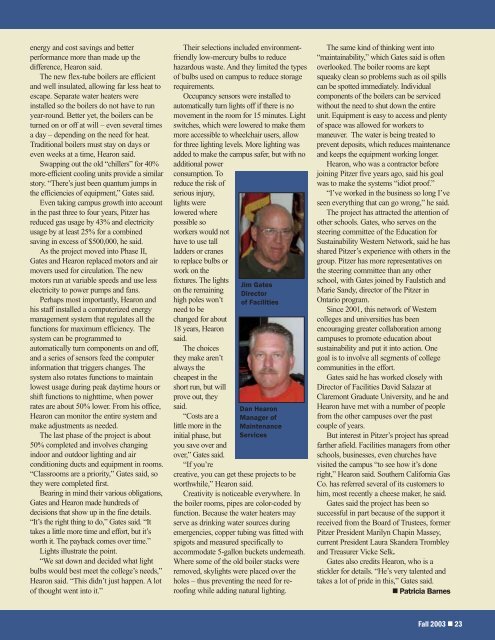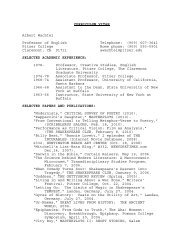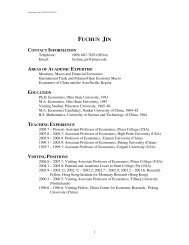Fall 2003 Participant - Pitzer College
Fall 2003 Participant - Pitzer College
Fall 2003 Participant - Pitzer College
Create successful ePaper yourself
Turn your PDF publications into a flip-book with our unique Google optimized e-Paper software.
energy and cost savings and better<br />
performance more than made up the<br />
difference, Hearon said.<br />
The new flex-tube boilers are efficient<br />
and well insulated, allowing far less heat to<br />
escape. Separate water heaters were<br />
installed so the boilers do not have to run<br />
year-round. Better yet, the boilers can be<br />
turned on or off at will – even several times<br />
a day – depending on the need for heat.<br />
Traditional boilers must stay on days or<br />
even weeks at a time, Hearon said.<br />
Swapping out the old “chillers” for 40%<br />
more-efficient cooling units provide a similar<br />
story. “There’s just been quantum jumps in<br />
the efficiencies of equipment,” Gates said.<br />
Even taking campus growth into account<br />
in the past three to four years, <strong>Pitzer</strong> has<br />
reduced gas usage by 43% and electricity<br />
usage by at least 25% for a combined<br />
saving in excess of $500,000, he said.<br />
As the project moved into Phase II,<br />
Gates and Hearon replaced motors and air<br />
movers used for circulation. The new<br />
motors run at variable speeds and use less<br />
electricity to power pumps and fans.<br />
Perhaps most importantly, Hearon and<br />
his staff installed a computerized energy<br />
management system that regulates all the<br />
functions for maximum efficiency. The<br />
system can be programmed to<br />
automatically turn components on and off,<br />
and a series of sensors feed the computer<br />
information that triggers changes. The<br />
system also rotates functions to maintain<br />
lowest usage during peak daytime hours or<br />
shift functions to nighttime, when power<br />
rates are about 50% lower. From his office,<br />
Hearon can monitor the entire system and<br />
make adjustments as needed.<br />
The last phase of the project is about<br />
50% completed and involves changing<br />
indoor and outdoor lighting and air<br />
conditioning ducts and equipment in rooms.<br />
“Classrooms are a priority,” Gates said, so<br />
they were completed first.<br />
Bearing in mind their various obligations,<br />
Gates and Hearon made hundreds of<br />
decisions that show up in the fine details.<br />
“It’s the right thing to do,” Gates said. “It<br />
takes a little more time and effort, but it’s<br />
worth it. The payback comes over time.”<br />
Lights illustrate the point.<br />
“We sat down and decided what light<br />
bulbs would best meet the college’s needs,”<br />
Hearon said. “This didn’t just happen. A lot<br />
of thought went into it.”<br />
Their selections included environmentfriendly<br />
low-mercury bulbs to reduce<br />
hazardous waste. And they limited the types<br />
of bulbs used on campus to reduce storage<br />
requirements.<br />
Occupancy sensors were installed to<br />
automatically turn lights off if there is no<br />
movement in the room for 15 minutes. Light<br />
switches, which were lowered to make them<br />
more accessible to wheelchair users, allow<br />
for three lighting levels. More lighting was<br />
added to make the campus safer, but with no<br />
additional power<br />
consumption. To<br />
reduce the risk of<br />
serious injury,<br />
lights were<br />
lowered where<br />
possible so<br />
workers would not<br />
have to use tall<br />
ladders or cranes<br />
to replace bulbs or<br />
work on the<br />
fixtures. The lights<br />
on the remaining<br />
high poles won’t<br />
need to be<br />
changed for about<br />
18 years, Hearon<br />
said.<br />
The choices<br />
they make aren’t<br />
always the<br />
cheapest in the<br />
short run, but will<br />
prove out, they<br />
said.<br />
“Costs are a<br />
little more in the<br />
initial phase, but<br />
you save over and<br />
over,” Gates said.<br />
“If you’re<br />
Jim Gates<br />
Director<br />
of Facilities<br />
Dan Hearon<br />
Manager of<br />
Maintenance<br />
Services<br />
creative, you can get these projects to be<br />
worthwhile,” Hearon said.<br />
Creativity is noticeable everywhere. In<br />
the boiler rooms, pipes are color-coded by<br />
function. Because the water heaters may<br />
serve as drinking water sources during<br />
emergencies, copper tubing was fitted with<br />
spigots and measured specifically to<br />
accommodate 5-gallon buckets underneath.<br />
Where some of the old boiler stacks were<br />
removed, skylights were placed over the<br />
holes – thus preventing the need for reroofing<br />
while adding natural lighting.<br />
The same kind of thinking went into<br />
“maintainability,” which Gates said is often<br />
overlooked. The boiler rooms are kept<br />
squeaky clean so problems such as oil spills<br />
can be spotted immediately. Individual<br />
components of the boilers can be serviced<br />
without the need to shut down the entire<br />
unit. Equipment is easy to access and plenty<br />
of space was allowed for workers to<br />
maneuver. The water is being treated to<br />
prevent deposits, which reduces maintenance<br />
and keeps the equipment working longer.<br />
Hearon, who was a contractor before<br />
joining <strong>Pitzer</strong> five years ago, said his goal<br />
was to make the systems “idiot proof.”<br />
“I’ve worked in the business so long I’ve<br />
seen everything that can go wrong,” he said.<br />
The project has attracted the attention of<br />
other schools. Gates, who serves on the<br />
steering committee of the Education for<br />
Sustainability Western Network, said he has<br />
shared <strong>Pitzer</strong>’s experience with others in the<br />
group. <strong>Pitzer</strong> has more representatives on<br />
the steering committee than any other<br />
school, with Gates joined by Faulstich and<br />
Marie Sandy, director of the <strong>Pitzer</strong> in<br />
Ontario program.<br />
Since 2001, this network of Western<br />
colleges and universities has been<br />
encouraging greater collaboration among<br />
campuses to promote education about<br />
sustainability and put it into action. One<br />
goal is to involve all segments of college<br />
communities in the effort.<br />
Gates said he has worked closely with<br />
Director of Facilities David Salazar at<br />
Claremont Graduate University, and he and<br />
Hearon have met with a number of people<br />
from the other campuses over the past<br />
couple of years.<br />
But interest in <strong>Pitzer</strong>’s project has spread<br />
farther afield. Facilities managers from other<br />
schools, businesses, even churches have<br />
visited the campus “to see how it’s done<br />
right,” Hearon said. Southern California Gas<br />
Co. has referred several of its customers to<br />
him, most recently a cheese maker, he said.<br />
Gates said the project has been so<br />
successful in part because of the support it<br />
received from the Board of Trustees, former<br />
<strong>Pitzer</strong> President Marilyn Chapin Massey,<br />
current President Laura Skandera Trombley<br />
and Treasurer Vicke Selk.<br />
Gates also credits Hearon, who is a<br />
stickler for details. “He’s very talented and<br />
takes a lot of pride in this,” Gates said.<br />
Patricia Barnes<br />
<strong>Fall</strong> <strong>2003</strong> 23






![Anticipated Courses SP14 [pdf] - Pomona College](https://img.yumpu.com/25363335/1/190x245/anticipated-courses-sp14-pdf-pomona-college.jpg?quality=85)










